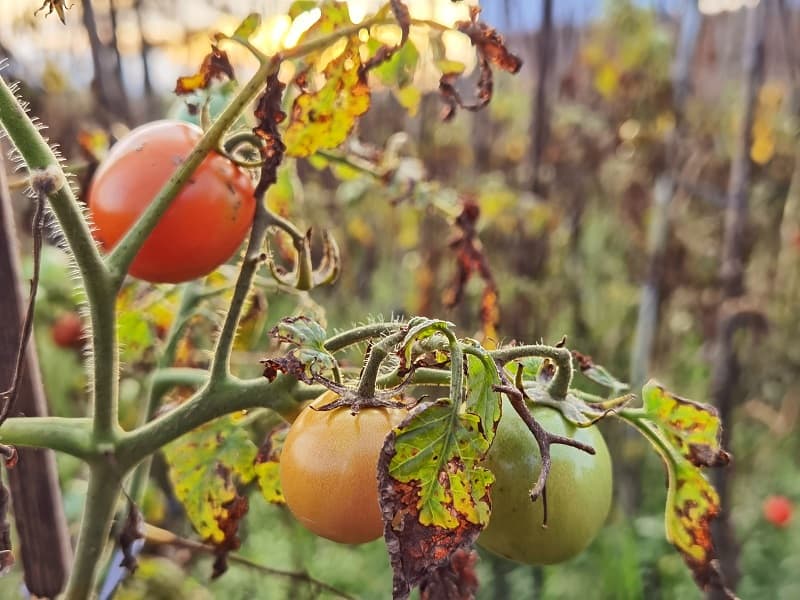
Tomatoes are ideal backyard plants, as they are common food staples and a must-have in most salads. Their scientific name is Solanum lycopersicum, of the family Solanaceae. You may notice some of your tomato plant’s leaves turning yellow at some stage – read on for some helpful information on why that might happen and how to prevent it.
Tomato Plant Leaves Turning Yellow: Common Reasons
Here are some common reasons tomato plant leaves may turn yellow:
1. Fungal disease
Yellow leaves on tomatoes could be attributed to fungal diseases. This includes early blight, which is characterized by yellow leaves and small lesions, which could grow larger and eventually take on a bulls-eye look. The fruits are not affected unless the infection is severe. Late blight is more harmful since it starts on the upper leaves; it is recognizable by the large, oily-looking lesions on the leaves and stems.
Fusarium wilt causes yellowing on one side of the plants and will begin with the older, bottom leaves. The growth becomes stunted and no fruits are produced.
These fungal diseases are usually treated with a fungicide that contains chlorothalonil. Allow space between the plants for ample air circulation and water the plants properly.
2. Viral disease
Viral diseases could also cause tomato leaves to turn yellow, including tomato mosaic virus, single streak virus, cucumber mosaic virus, and tomato yellow leaf curl.
Most tomato viruses are characterized by stunted growth and mosaic leaf patterns. Some viruses may cause malformations like a fern leaf, broccoli-like growth, severe curling, or brown streaks. These diseases are usually spread by pests such as aphids, thrips and whiteflies, or by tools or hands.
Plants may not survive these viral diseases and there are no chemical controls. The best course of action is usually to discard the infected tomato plants and plant new disease-resistant varieties in a new location or section of your garden. Maintenance of proper pest control and a watering schedule should also be followed.
3. Pest infestation
Pests can invade tomato plants and may cause yellowing leaves. Common pests include aphids, thrips, flea beetles, whiteflies and spider mites. These can be treated with insecticidal soap or horticultural oil such as neem oil.
4. A watering problem
Being overwatered or underwatered can also cause tomato leaves to yellow. To prevent this, soak the plants thoroughly at least once every five to seven days, depending on the soil type and the weather. Allow the soil to dry up between watering and never allow it to remain soggy. Water the base of the plants carefully, keeping the leaves dry, and ideally only water them in the early morning.
5. Nutritional deficiencies
Tomato plant leaves may also turn yellow due to nutritional deficiencies, either because leaves are not getting the nutrients they need from the soil, or due to insufficient sunlight. This usually happens on older fruit-bearing plants and may be a result of a lack of nitrogen. You need to do a soil test to determine which nutrients are lacking. Fertilize the plants at planting time and monthly throughout the season. Follow the instructions carefully to avoid overfeeding.
Homemade compost can keep the soil rich and full of nutrients, preventing the need for fertilizers, especially in organic gardens. Mulching can also conserve moisture.
Cottonseed meal is also a natural tomato fertilizer that you can mix into the soil at planting time. Its main contents include nitrogen, potassium and phosphorus, as well as calcium, sulfur, magnesium, copper, manganese and zinc. Nitrogen supports the leafy growth of young plants. These nutrients are released gradually for four months.
Should I Remove Yellow Leaves from My Tomato Plants?
Yes, you can remove yellow leaves from your plants as long as they are below the first set. When most tomato plants reach a height of 12 to 18 inches, it is natural for some of the leaves to turn yellow or start to wither.
Can Yellow Leaves Turn Green Again?
It is unlikely that yellow leaves will turn green again unless the cause is nutritional deficiency. If this is the case, it can be rectified and the green color may return, although in most cases it is unlikely.
What Nutrient Deficiency Causes Yellow Leaves?
Nitrogen deficiency causes yellow leaves. Inner, older leaves turn yellow first. The yellowing moves outward and eventually reaches the young leaves. Potassium deficiency manifests as leaf edges turning bright yellow while the inner ones stay green.
Conclusion
Tomato plants are very productive and easy to cultivate. They love the sun and are remarkably long-season plants. However, they can also suffer from diseases and infections, some of which can cause their leaves to turn yellow. Common reasons for leaf yellowing may include overwatering or underwatering, as well as nutritional deficiencies. It could also be due to fungal or viral disease or pest infestation.
Image: istockphoto.com / Rini Indrawati